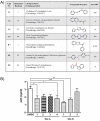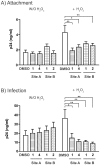Dendritic cell immunoreceptor is a new target for anti-AIDS drug development: identification of DCIR/HIV-1 inhibitors
- PMID: 23874461
- PMCID: PMC3706466
- DOI: 10.1371/journal.pone.0067873
Dendritic cell immunoreceptor is a new target for anti-AIDS drug development: identification of DCIR/HIV-1 inhibitors
Abstract
The HIV-1 pandemic continues to expand while no effective vaccine or cure is yet available. Existing therapies have managed to limit mortality and control viral proliferation, but are associated with side effects, do not cure the disease and are subject to development of resistance. Finding new therapeutic targets and drugs is therefore crucial. We have previously shown that the dendritic cell immunoreceptor (DCIR), a C-type lectin receptor expressed on dendritic cells (DCs), acts as an attachment factor for HIV-1 to DCs and contributes to HIV-1 transmission to CD4(+) T lymphocytes (CD4TL). Directly involved in HIV-1 infection, DCIR is expressed in apoptotic or infected CD4TL and promotes trans-infection to bystander cells. Here we report the 3D modelling of the extracellular domain of DCIR. Based on this structure, two surface accessible pockets containing the carbohydrate recognition domain and the EPS binding motif, respectively, were targeted for screening of chemicals that will disrupt normal interaction with HIV-1 particle. Preliminary screening using Raji-CD4-DCIR cells allowed identification of two inhibitors that decreased HIV-1 attachment and propagation. The impact of these inhibitors on infection of DCs and CD4TL was evaluated as well. The results of this study thus identify novel molecules capable of blocking HIV-1 transmission by DCs and CD4TL.
Conflict of interest statement
Figures









References
-
- Deeks SG, Phillips AN (2009) HIV infection, antiretroviral treatment, ageing, and non-AIDS related morbidity. BMJ 338: a3172. - PubMed
-
- Haase AT (2010) Targeting early infection to prevent HIV-1 mucosal transmission. Nature 464: 217–223. - PubMed
-
- Blanchet F, Moris A, Mitchell JP, Piguet V (2011) A look at HIV journey: from dendritic cells to infection spread in CD4+ T cells. Curr Opin HIV AIDS 6: 391–397. - PubMed
Publication types
MeSH terms
Substances
Grants and funding
LinkOut - more resources
Full Text Sources
Other Literature Sources
Medical
Research Materials

